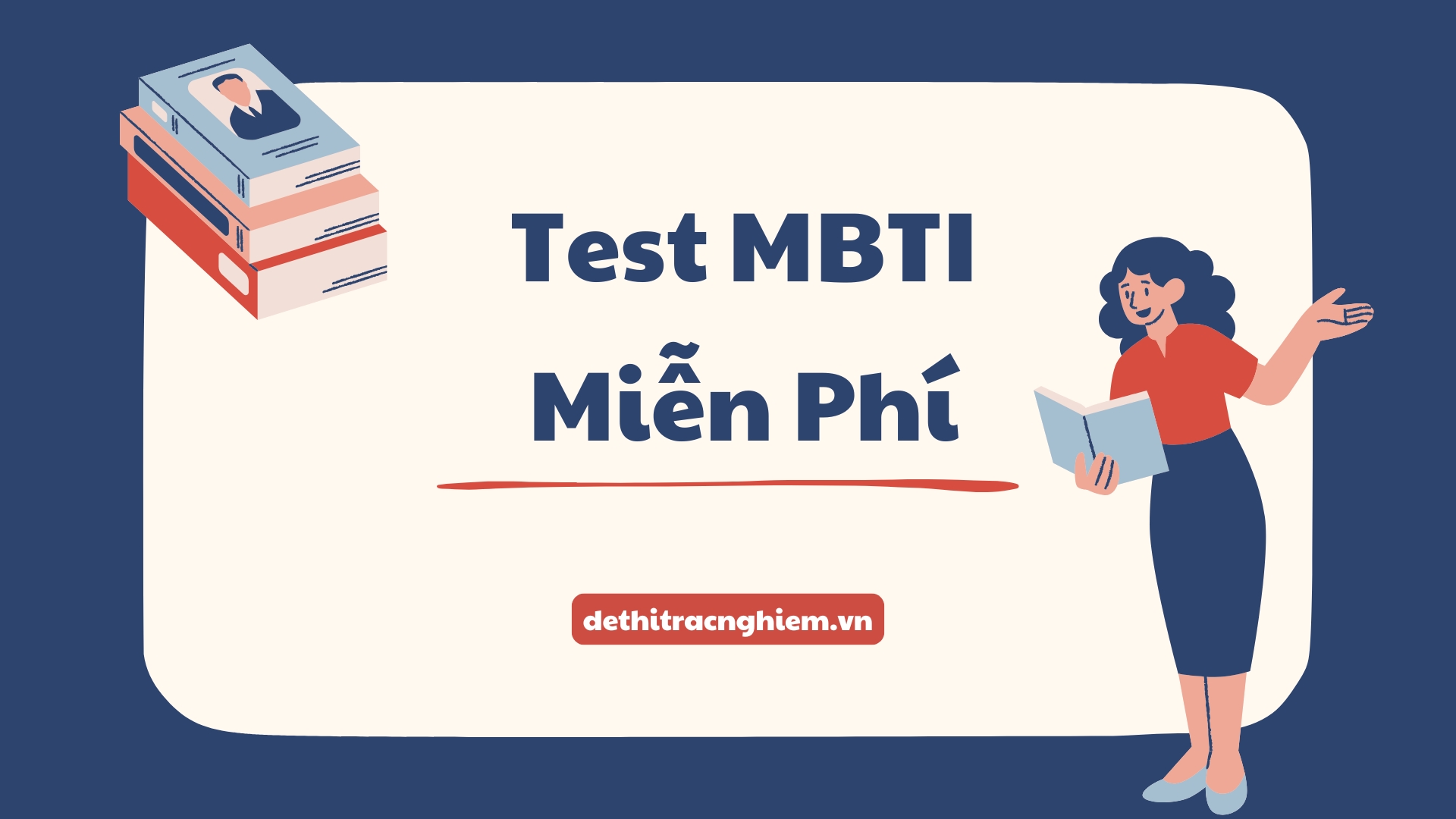Đề thi thử Đại học 2025 môn Tiếng Anh – THPT Kinh Môn – Hải Dương là một trong những đề tiêu biểu thuộc Tổng hợp đề thi thử môn Tiếng Anh THPT QG, nằm trong chương trình Đề thi vào Đại học. Đây là đề thi được xây dựng sát với định hướng ra đề mới nhất của Bộ GD&ĐT, phù hợp với cấu trúc đề thi tốt nghiệp THPT môn Tiếng Anh năm 2025.
Đề thi này bao gồm đầy đủ các dạng bài quan trọng như: phát âm – trọng âm, ngữ pháp cơ bản và nâng cao, từ vựng theo chủ đề, đọc hiểu, điền từ vào đoạn văn (cloze test) và viết lại câu (sentence transformation). Đặc biệt, phần đọc hiểu và phân tích ngữ cảnh trong đề mang tính phân loại cao, đòi hỏi học sinh không chỉ nắm chắc kiến thức ngôn ngữ mà còn phải có khả năng suy luận, tổng hợp và quản lý thời gian tốt trong quá trình làm bài.
Hãy cùng Dethitracnghiem.vn khám phá ngay đề thi thử này và bắt tay vào luyện tập để sẵn sàng cho kỳ thi THPT Quốc gia sắp tới!
- Số trang: 4 trang
- Hình thức: Trắc nghiệm
- Thời gian làm bài: 50 phút (không kể thời gian phát đề)
ĐỀ THI THỬ ĐẠI HỌC MÔN TIẾNG ANH NĂM 2025 THPT KINH MÔN – HẢI DƯƠNG
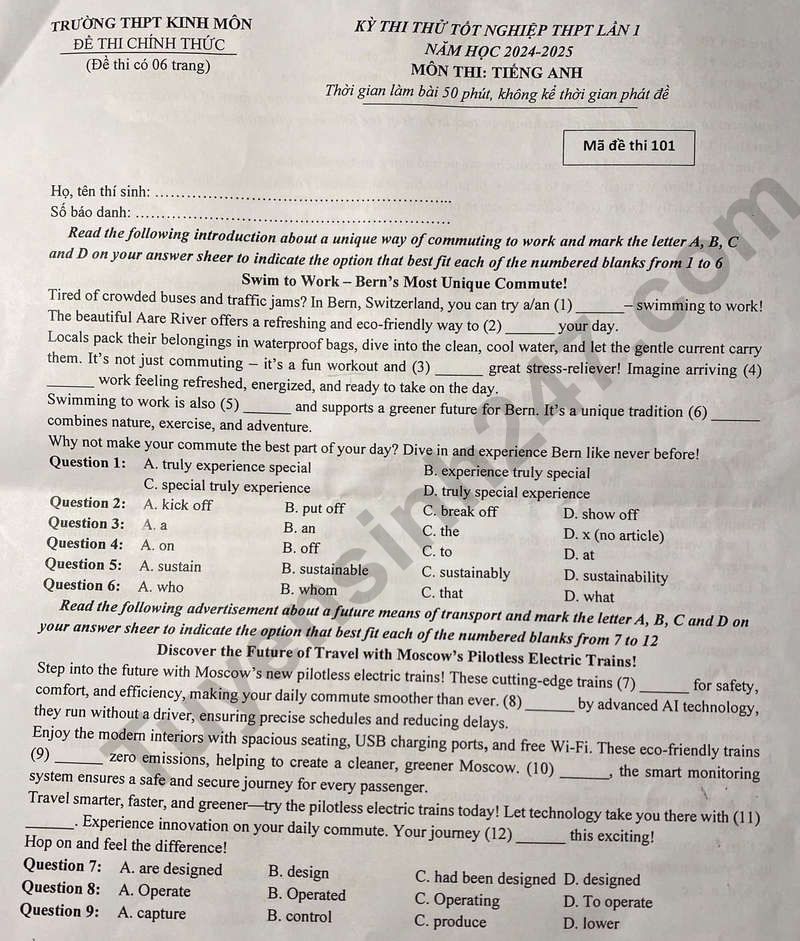
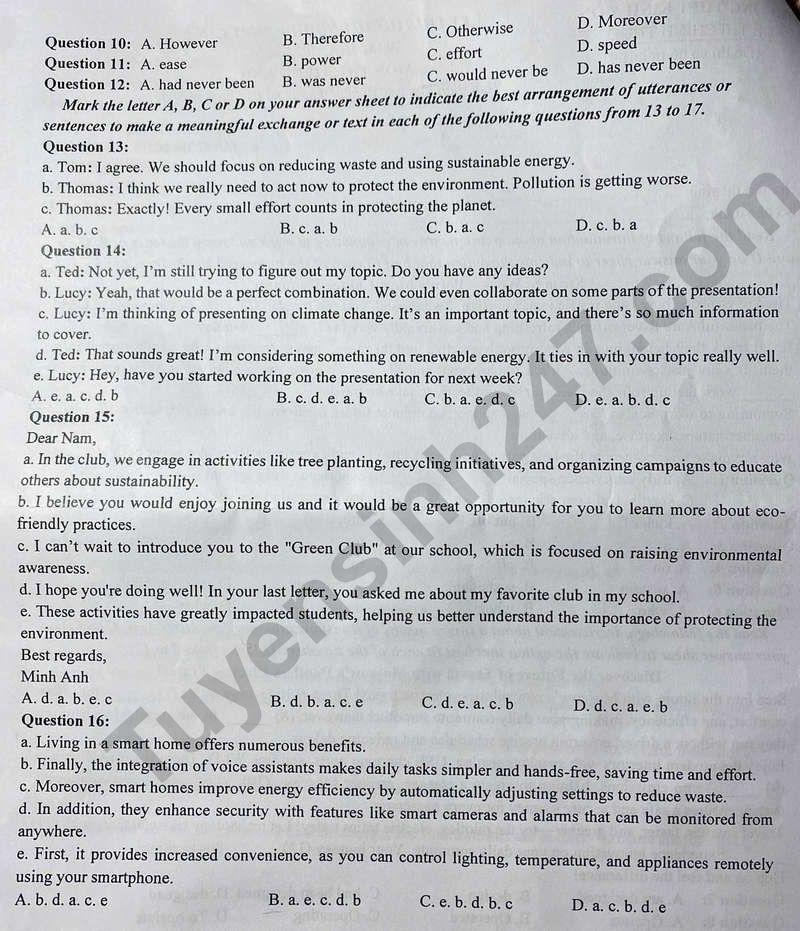
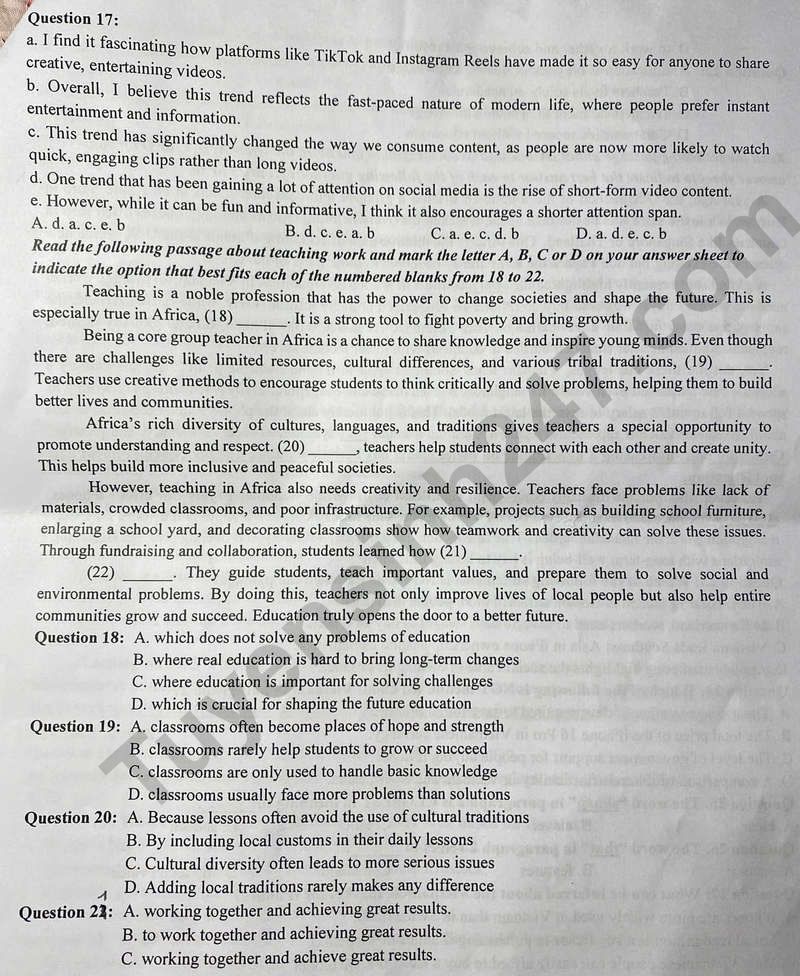

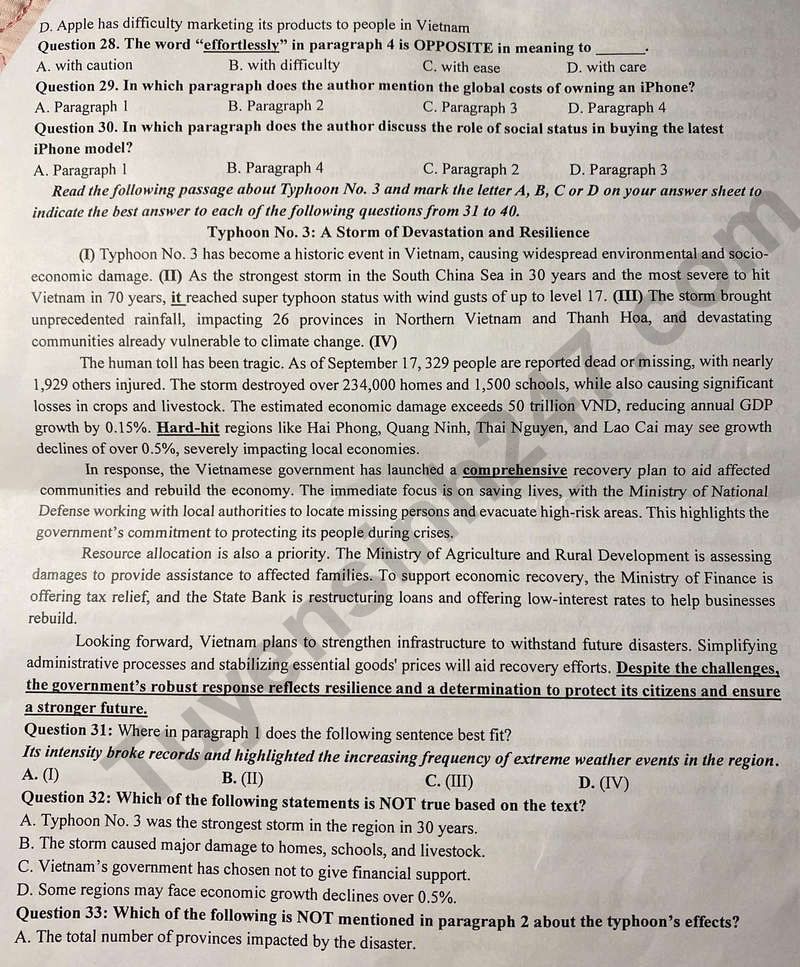
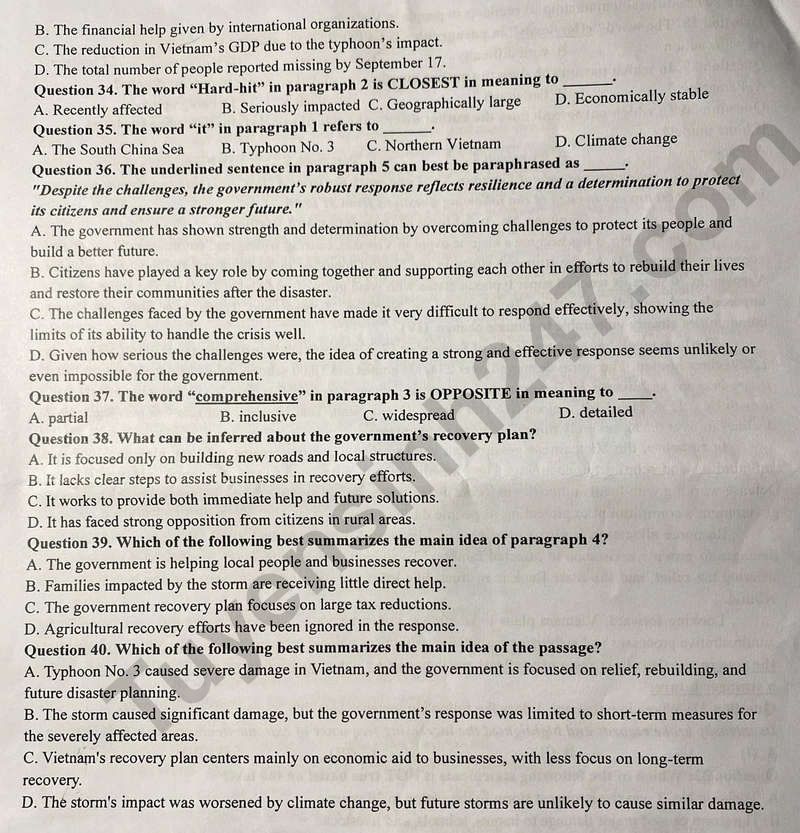
Read the following introduction about a unique way of commuting to work and mark the letter A, B, C and D on your answer sheer to indicate the option that best fit each of the numbered blanks from 1 to 6.
Swim to Work – Bern’s Most Unique Commute!
Tired of crowded buses and traffic jams? In Bern, Switzerland, you can try a/an (1)______ – swimming to work! The beautiful Aare River offers a refreshing and eco-friendly way to (2)______ your day.
Locals pack their belongings in waterproof bags, dive into the clean, cool water, and let the gentle current carry them. It’s not just commuting – it’s a fun workout and (3)______ great stress-reliever! Imagine arriving (4)______ work feeling refreshed, energized, and ready to take on the day.
Swimming to work is also (5)______ and supports a greener future for Bern. It’s a unique tradition (6)______ combines nature, exercise, and adventure.
Why not make your commute the best part of your day? Dive in and experience Bern like never before!
Question 1:
A. truly experience special
B. experience truly special
C. special truly experience
D. truly special experience
Question 2:
A. kick off
B. put off
C. break off
D. show off
Question 3:
A. a
B. an
C. the
D. x (no article)
Question 4:
A. on
B. off
C. to
D. at
Question 5:
A. sustain
B. sustainable
C. sustainably
D. sustainability
Question 6:
A. who
B. whom
C. that
D. what
Read the following advertisement about a future means of transport and mark the letter A, B, C and D on your answer sheer to indicate the option that best fit each of the numbered blanks from 7 to 12.
Discover the Future of Travel with Moscow’s Pilotless Electric Trains!
Step into the future with Moscow’s new pilotless electric trains! These cutting-edge trains (7)______ for safety, comfort, and efficiency, making your daily commute smoother than ever. (8)______ by advanced AI technology, they run without a driver, ensuring precise schedules and reducing delays.
Enjoy the modern interiors with spacious seating, USB charging ports, and free Wi-Fi. These eco-friendly trains (9)______ zero emissions, helping to create a cleaner, greener Moscow. (10)______ the smart monitoring system ensures a safe and secure journey for every passenger.
Travel smarter, faster, and greener—try the pilotless electric trains today! Let technology take you there with (11)______ Experience innovation on your daily commute. Your journey (12)______ this exciting! Hop on and feel the difference!
Question 7:
A. are designed
B. design
C. had been designed
D. designed
Question 8:
A. Operate
B. Operated
C. Operating
D. To operate
Question 9:
A. capture
B. control
C. produce
D. lower
Question 10:
A. However
B. Therefore
C. Otherwise
D. Moreover
Question 11.
A. ease
B. power
C. effort
D. speed
Question 12.
A. had never been
B. was never
C. would never be
D. has never been
Mark the letter A, B, C or D on your answer sheet to indicate the best arrangement of utterances or sentences to make a meaningful exchange or text in each of the following questions from 13 to 17.
Question 13:
a. Tom: I agree. We should focus on reducing waste and using sustainable energy.
b. Thomas: I think we really need to act now to protect the environment. Pollution is getting worse.
c. Thomas: Exactly! Every small effort counts in protecting the planet.
A. a, a, b, c
B. b, a, c
C. b, c, a
D. c, b, a
Question 14:
a. Ted: Not yet, I’m still trying to figure out my topic. Do you have any ideas?
b. Lucy: Yeah, that would be a perfect combination. We could even collaborate on some parts of the presentation!
c. Lucy: I’m thinking of presenting on climate change. It’s an important topic, and there’s so much information to cover.
d. Ted: That sounds great! I’m considering something on renewable energy. It ties in with your topic really well.
e. Lucy: Hey, have you started working on the presentation for next week?
A. e, a, c, d, b
B. c, d, e, a, b
C. b, a, e, d, c
D. e, a, b, d, c
Question 15:
Dear Nam,
a. In the club, we engage in activities like tree planting, recycling initiatives, and organizing campaigns to educate others about sustainability.
b. I believe you would enjoy joining us and it would be a great opportunity for you to learn more about eco-friendly practices.
c. I can’t wait to introduce you to the “Green Club” at our school, which is focused on raising environmental awareness.
d. I hope you’re doing well! In your last letter, you asked me about my favorite club in my school.
e. These activities have greatly impacted students, helping us better understand the importance of protecting the environment.
Best regards,
Minh Anh
A. d, a, b, e, c
B. d, b, a, c, e
C. d, e, a, c, b
D. d, c, a, e, b
Question 16:
a. Living in a smart home offers numerous benefits.
b. Finally, the integration of voice assistants makes daily tasks simpler and hands-free, saving time and effort.
c. Moreover, smart homes improve energy efficiency by automatically adjusting settings to reduce waste.
d. In addition, they enhance security with features like smart cameras and alarms that can be monitored from anywhere.
e. First, it provides increased convenience, as you can control lighting, temperature, and appliances remotely using your smartphone.
A. b, d, a, c, e
B. a, e, c, d, b
C. e, b, d, b, c
D. a, c, b, d, e
Question 17:
a. I find it fascinating how platforms like TikTok and Instagram Reels have made it so easy for anyone to share creative, entertaining videos.
b. Overall, I believe this trend reflects the fast-paced nature of modern life, where people prefer instant entertainment and information.
c. This trend has significantly changed the way we consume content, as people are now more likely to watch quick, engaging clips rather than long videos.
d. One trend that has been gaining a lot of attention on social media is the rise of short-form video content.
e. However, while it can be fun and informative, I think it also encourages a shorter attention span.
A. d, a, c, e, b
B. d, c, e, a, b
C. a, c, e, d, b
D. a, d, e, c, b
Read the following passage about teaching work and mark the letter A, B, C or D on your answer sheet to indicate the option that best fits each of the numbered blanks from 18 to 22.
Teaching is a noble profession that has the power to change societies and shape the future. This is especially true in Africa, (18) ______.It is a strong tool to fight poverty and bring growth.
Being a core group teacher in Africa is a chance to share knowledge and inspire young minds. Even though there are challenges like limited resources, cultural differences, and various tribal traditions, (19) ______. Teachers use creative methods to encourage students to think critically and solve problems, helping them to build better lives and communities.
Africa’s rich diversity of cultures, languages, and traditions gives teachers a special opportunity to promote understanding and respect. (20) ______, teachers help students connect with each other and create unity. This helps build more inclusive and peaceful societies.
However, teaching in Africa also needs creativity and resilience. Teachers face problems like lack of materials, crowded classrooms, and poor infrastructure. For example, projects such as building school furniture, enlarging a school yard, and decorating classrooms show how teamwork and creativity can solve these issues. Through fundraising and collaboration, students learned how (21) ______.
(22) ______.They guide students, teach important values, and prepare them to solve social and environmental problems. By doing this, teachers not only improve lives of local people but also help entire communities grow and succeed. Education truly opens the door to a better future.
Question 18:
A. which does not solve any problems of education
B. where real education is hard to bring long-term changes
C. where education is important for solving challenges
D. which is crucial for shaping the future education
Question 19:
A. Classrooms often become places of hope and strength
B. classrooms rarely help students to grow or succeed
C. classrooms are only used to handle basic knowledge
D. classrooms usually face more problems than solutions
Question 20:
A. Because lessons often avoid the use of cultural traditions
B. By including local customs in their daily lessons
C. Cultural diversity often leads to more serious issues
D. Adding local traditions rarely makes any difference
Question 21:
A. working together and achieving great results.
B. to work together and achieving great results.
C. working together and achieve great results.
D. to work together and achieve great results.
Question 22:
A. Education is only about sharing knowledge
B. Teachers focus solely on academics
C. Teachers do more than share knowledge
D. Communities succeed without education
Read the following passage about iPhone and its social symbol and mark the letter A, B, C or D on your answer sheet to indicate the best answer to each of the following questions from 23 to 30.
A year ago, the U.S. launch of the iPhone 15 offered a glimpse into consumer habits at an Apple Store in Boston. While the store was busier than usual, it lacked the overwhelming crowds and long queues often seen in countries like Singapore or Thailand. This reflects the relative ease of accessing iPhones in the U.S., where new releases are exciting but don’t spark the same frenzy observed in other parts of the world.
A global study recently highlighted the **sharp** contrast in iPhone affordability. In Vietnam, an average worker needs to save 53 days’ wages to buy an iPhone 16 Pro, priced at 28.99 million VND, while in Switzerland, the same phone costs just four days’ earnings. This difference reveals how the iPhone, though globally desired, represents a much heavier financial burden in countries with lower income levels.
Yet, despite these challenges, Vietnam leads Southeast Asia in iPhone ownership. In 2022, the country’s adoption rate surpassed even wealthier neighbors like Thailand and Singapore. Many Vietnamese are willing to spend a full month’s salary to own the latest model. This is not merely about the phone’s advanced features but about the social value it represents. Apple has crafted a brand **that** symbolizes success, identity, and prestige. **Unboxing and showcasing a new iPhone on social media has become a public display of achievement and sophistication.**
However, this pursuit of status comes with significant costs. While wealthier buyers can afford iPhones **effortlessly**, others face financial strain or debt to own one. This raises a deeper question: Is the desire for social recognition worth the financial burden? True satisfaction lies in financial stability, not fleeting prestige. Balancing aspirations with long-term well-being is key to lasting fulfillment.
Question 23: Which of the following statements is NOT true based on the passage?
A. The iPhone 15 launch in Boston attracted more people than usual.
B. In Switzerland, workers need to save 50 days’ wages to buy an iPhone.
C. Vietnam leads Southeast Asia in iPhone ownership despite its high cost.
D. Apple’s marketing highlights the social value of owning its products.
Question 24: Which of the following is NOT mentioned in Vietnam in paragraph 2?
A. The average number of days required to save for an iPhone.
B. The total price of the iPhone 16 Pro in Vietnamese currency.
C. The level of government support for people buying iPhones.
D. A comparison of iPhone affordability in Vietnam and Switzerland.
Question 25. The word “**sharp**” in paragraph 2 is CLOSEST in meaning to ______.
A. clear
B. clever
C. quick
D. sudden
Question 26. The word “**that**” in paragraph 2 refers to ______.
A. success
B. features
C. a brand
D. the social value
Question 27: What can be inferred about the Vietnamese market for iPhones?
A. iPhones are more widely used in Vietnam than in Switzerland.
B. Social recognition is a key factor in purchasing iPhones in Vietnam.
C. Most Vietnamese people can easily afford to buy a latest iPhone model
D. Apple has difficulty marketing its products to people in Vietnam
Question 28. The word “**effortlessly**” in paragraph 4 is OPPOSITE in meaning to ______.
A. with caution
B. with difficulty
C. with ease
D. with care
Question 29. In which paragraph does the author mention the global costs of owning an iPhone?
A. Paragraph 1
B. Paragraph 2
C. Paragraph 3
D. Paragraph 4
Question 30. In which paragraph does the author discuss the role of social status in buying the latest iPhone model?
A. Paragraph 1
B. Paragraph 4
C. Paragraph 2
D. Paragraph 3
Read the following passage about Typhoon No. 3 and mark the letter A, B, C or D on your answer sheet to indicate the best answer to each of the following questions from 31 to 40.
Typhoon No. 3: A Storm of Devastation and Resilience
(I) Typhoon No. 3 has become a historic event in Vietnam, causing widespread environmental and socio-economic damage. (II) As the strongest storm in the South China Sea in 30 years and the most severe to hit Vietnam in 70 years, it reached super typhoon status with wind gusts of up to level 17. (III) The storm brought unprecedented rainfall, impacting 26 provinces in Northern Vietnam and Thanh Hoa, and devastating communities already vulnerable to climate change. (IV)
The human toll has been tragic. As of September 17, 329 people are reported dead or missing, with nearly 1,929 others injured. The storm destroyed over 234,000 homes and 1,500 schools, while also causing significant losses in crops and livestock. The estimated economic damage exceeds 50 trillion VND, reducing annual GDP growth by 0.15%. **Hard-hit** regions like Hai Phong, Quang Ninh, Thai Nguyen, and Lao Cai may see growth declines of over 0.5%, severely impacting local economies.
In response, the Vietnamese government has launched a **comprehensive** recovery plan to aid affected communities and rebuild the economy. The immediate focus is on saving lives, with the Ministry of National Defense working with local authorities to locate missing persons and evacuate high-risk areas. This highlights the government’s commitment to protecting its people during crises.
Resource allocation is also a priority. The Ministry of Agriculture and Rural Development is assessing damages to provide assistance to affected families. To support economic recovery, the Ministry of Finance is offering tax relief, and the State Bank is restructuring loans and offering low-interest rates to help businesses rebuild.
Looking forward, Vietnam plans to strengthen infrastructure to withstand future disasters. Simplifying administrative processes and stabilizing essential goods’ prices will aid recovery efforts. Despite the challenges, **the government’s robust response reflects resilience and a determination to protect its citizens and ensure a stronger future.**
Question 31: Where in paragraph 1 does the following sentence best fit? Its intensity broke records and highlighted the increasing frequency of extreme weather events in the region.
A. (I)
B. (II)
C. (III)
D. (IV)
Question 32: Which of the following statements is NOT true based on the text?
A. Typhoon No. 3 was the strongest storm in the region in 30 years.
B. The storm caused major damage to homes, schools, and livestock.
C. Vietnam’s government has chosen not to give financial support.
D. Some regions may face economic growth declines over 0.5%.
Question 33: Which of the following is NOT mentioned in paragraph 2 about the typhoon’s effects?
A. The total number of provinces impacted by the disaster.
B. The financial help given by international organizations.
C. The reduction in Vietnam’s GDP due to the typhoon’s impact.
D. The total number of people reported missing by September 17.
Question 34. The word “**Hard-hit**” in paragraph 2 is CLOSEST in meaning to ______.
A. Recently affected
B. Seriously impacted
C. Geographically large
D. Economically stable
Question 35. The word “**it**” in paragraph 1 refers to ______.
A. The South China Sea
B. Typhoon No. 3
C. Northern Vietnam
D. Climate change
Question 36. The underlined sentence in paragraph 5 can best be paraphrased as ______. “Despite the challenges, the government’s robust response reflects resilience and a determination to protect its citizens and ensure a stronger future.”
A. The government has shown strength and determination by overcoming challenges to protect its people and build a better future.
B. Citizens have played a key role by coming together and supporting each other in efforts to rebuild their lives and restore their communities after the disaster.
C. The challenges faced by the government have made it very difficult to respond effectively, showing the limits of its ability to handle the crisis well.
D. Given how serious the challenges were, the idea of creating a strong and effective response seems unlikely or even impossible for the government.
Question 37. The word “**comprehensive**” in paragraph 3 is OPPOSITE in meaning to ______.
A. partial
B. inclusive
C. widespread
D. detailed
Question 38. What can be inferred about the government’s recovery plan?
A. It is focused only on building new roads and local structures.
B. It lacks clear steps to assist businesses in recovery efforts.
C. It works to provide both immediate help and future solutions.
D. It has faced strong opposition from citizens in rural areas.
Question 39. Which of the following best summarizes the main idea of paragraph 4?
A. The government is helping local people and businesses recover.
B. Families impacted by the storm are receiving little direct help.
C. The government recovery plan focuses on large tax reductions.
D. Agricultural recovery efforts have been ignored in the response.
Question 40. Which of the following best summarizes the main idea of the passage?
A. Typhoon No. 3 caused severe damage in Vietnam, and the government is focused on relief, rebuilding, and future disaster planning.
B. The storm caused significant damage, but the government’s response was limited to short-term measures for the severely affected areas.
C. Vietnam’s recovery plan centers mainly on economic aid to businesses, with less focus on long-term recovery.
D. The storm’s impact was worsened by climate change, but future storms are unlikely to cause similar damage.
Mục đích tổ chức kỳ thi Đại học năm 2025 là gì?
Căn cứ theo quy chế hiện hành của Bộ Giáo dục và Đào tạo và các văn bản hướng dẫn tổ chức kỳ thi Đại học năm 2025, mục đích của kỳ thi là:
– Đánh giá kết quả học tập của học sinh sau 12 năm học theo yêu cầu của chương trình giáo dục phổ thông.
– Lấy kết quả thi để xét công nhận tốt nghiệp trung học phổ thông và làm căn cứ tuyển sinh đại học, cao đẳng.
– Góp phần đánh giá chất lượng giáo dục của địa phương và cả nước, làm cơ sở điều chỉnh nội dung, phương pháp dạy học trong nhà trường.
Thí sinh thi Đại học năm 2025 có bắt buộc thi môn Tiếng Anh không?
Theo quy định hiện hành của Bộ Giáo dục và Đào tạo và hướng dẫn tổ chức kỳ thi tốt nghiệp Đại học năm 2025, thí sinh dự thi phải thực hiện như sau:
– Thi 3 môn bắt buộc: Toán, Ngữ văn và Ngoại ngữ.
– Ngoài ra, thí sinh phải chọn một trong hai bài thi tổ hợp: Khoa học Tự nhiên (gồm các môn Vật lí, Hóa học, Sinh học) hoặc Khoa học Xã hội (gồm các môn Lịch sử, Địa lí, Giáo dục công dân – dành cho học sinh học chương trình giáo dục phổ thông).
Trong số các môn thi, Tiếng Anh là một trong ba môn thuộc bài thi Ngoại ngữ bắt buộc, thí sinh phải thi môn Tiếng Anh như một môn bắt buộc, không phụ thuộc vào lựa chọn bài thi tổ hợp hay mục đích xét tuyển đại học.
Như vậy, kỳ thi Đại học năm 2025 bắt buộc thí sinh phải thi môn Tiếng Anh.

